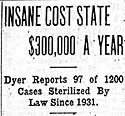

"The committee has recently received letters from the Governors of Vermont and Kentucky asking for information regarding legislation, and strongly endorsing the proposition that defectives, degenerates, and confirmed criminals should be sterilized. Both hope soon to secure legislation in their respective states legalizing the operation." |
Report of the Committee of the Eugenics Section |
Vermont's history of eugenic sterilization predated the Eugenics Survey by at least twelve years and continued long after the Survey closed. Yet Harry Perkins attibuted the final passage of Vermont's sterilization law of 1931 to the Eugenics Survey's public education campaigns. The current law governing sexual sterilization of mentally retarded persons has been stripped of all eugenic intent and provides a detailed procedure to protect the rights of the individual.
Vermont records documenting the implementation of sterilization laws are not open to the public. The Eugenics Survey records do not contain sterilization records, as the Survey was not authorized to act as a "state eugenics board," as other states had established. Hence, our understanding of the degree to which "voluntary sterilization" of Vermonters was either "informed" or "consensual," as the law required, awaits access to patient records that are currently protected by privacy and confidentiality statutes. Government documents, manuscripts, and press coverage of the legislative debates over sterilization, however, dramatize the political landscape in which the sterilization bill was made law and document the central role the Eugenics Survey played in the campaign for sterilization.
Vermont's first sterilization bill, passed in 1912, was vetoed by the
governor as unconstitutional.
Professor Harry Perkins renewed the quest for a eugenic sterilization
law in 1925 at the first meeting of the Eugenics Survey advisory committee.
Using legal precedents in other states and promotional literature from
the American Eugenics Society to bolster their case, the Eugenics Survey
and the Department of Public Welfare reconceived eugenic sterilization
as part of a comprehensive state program of supervision and social control
of mental deficiency.
 In
January,1927, Professor Perkins briefed the Vermont legislature on the
need for a sterilization law using his Survey's studies Poor Vermont families
(published as First
Annual Report, Lessons from a Eugenical Survey of Vermont).
The 1927 bill, "An Act Relating to Eugenic Sterilization," passed the Senate
by a vote of 21 to 6, but failed in the House by a vote of 126 to 54. Perkins
retreated from the sterilization issue in the next legislative session
of 1929 in order to protect the Vermont Commission of Country Life from
political controversy. In 1931, Professor Perkins, Dr. E. A. Stanley, Dr.
Truman Allen, and Public Welfare Commissioner William Dyer reactivated
the sterilization campaign, this time with the authority of the U. S. Supreme
Court decision, Buck v. Bell. While based on the presumption that physicians
could diagnose "hereditary feeblemindedness" or inherited mental illness,
the 1931 campaign for a eugenic sterilization law was waged on economic
and social grounds.
In
January,1927, Professor Perkins briefed the Vermont legislature on the
need for a sterilization law using his Survey's studies Poor Vermont families
(published as First
Annual Report, Lessons from a Eugenical Survey of Vermont).
The 1927 bill, "An Act Relating to Eugenic Sterilization," passed the Senate
by a vote of 21 to 6, but failed in the House by a vote of 126 to 54. Perkins
retreated from the sterilization issue in the next legislative session
of 1929 in order to protect the Vermont Commission of Country Life from
political controversy. In 1931, Professor Perkins, Dr. E. A. Stanley, Dr.
Truman Allen, and Public Welfare Commissioner William Dyer reactivated
the sterilization campaign, this time with the authority of the U. S. Supreme
Court decision, Buck v. Bell. While based on the presumption that physicians
could diagnose "hereditary feeblemindedness" or inherited mental illness,
the 1931 campaign for a eugenic sterilization law was waged on economic
and social grounds.
To learn more about the American sterilization laws, see:
Lombardo, Paul A. "Medicine, Eugenics and the Supreme Court: From Coercive Sterilization to Reproductive Freedom." Journal of Contemporary Health Law and Policy 13 (1996).
Paul, Julius. "State Eugenic Sterilization Laws in American Thought and Practice." Washington D.C.: Walter Reed Army Insitute of Research, 1965. Unpublished manuscript, copy in UVM Special Collections.
Reilly, Philip R. The Surgical Solution: A History of Involuntary Sterilization in the United States. Baltimore: Johns Hopkins University Press, 1991.
Robitscher, Jonas, ed. Eugenic Sterilization. Springfield, Ill.: Charles C. Thomas, 1973.